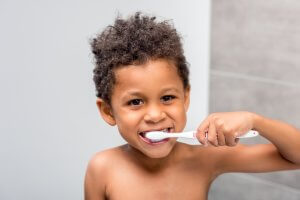It’s exciting when baby’s first tooth appears, but then what? From this moment forward, there is work to be done taking care of your child’s teeth and teaching them good habits. It’s a big responsibility, but we have lots of information to help you make the right choices for your family.
Our selection of articles about dental care for babies and children answers common questions from parents about all kinds of topics including:
- Baby teeth and adult teeth
- Teething
- Keeping your child’s teeth clean and healthy
- Choosing the right toothbrush and toothpaste
- What to do if you notice a problem with their teeth
- Taking kids to the dentist
You’ll find all of this – and much more about dental health – in the articles below.
Children’s oral health
If you’re looking for information on how to look after your child’s teeth, start here. Shockingly, around 43% of kids from the US have tooth decay. If you don’t want your child to be one of them, or you want to know how to prevent further damage to your child’s teeth, check out our guide to children’s oral health.


We have some great advice and tips, including ways to encourage your child to brush their teeth properly and how to promote healthy snacking. Additionally, you can find more information about brushing children’s teeth in our article about fun and informative dental facts.
You can also read about other common problems that affect children’s teeth and mouths, such as ulcers, gum disease, crooked teeth and dental injuries.
Begin oral hygiene steps for baby teeth as soon as you see the first one come into your child’s mouth. After that first baby tooth erupts through the gums, use a finger, or finger gum brush, to gently brush that baby tooth. This is especially important after nursing or after an infant takes a bottle, as milk sugars can promote decay of the baby teeth. Here are some tips to follow for healthy baby teeth:
- Avoid baby bottle tooth decay by never leaving a baby bottle with an infant overnight or when they sleep. Sucking all throughout the night, constantly exposes teeth to decay-causing sugars. This decay happens so easily, that it’s known as “baby-bottle tooth decay”.
- Use an infant brush that fits the size of the baby’s mouth. Use a tiny amount (rice-sized) of fluoride toothpaste for brushing.
- Wipe an infant’s teeth and gums with a wet cloth after eating to reduce plaque buildup.
- Brush teeth before bedtime, after nursing or bottle-feeding.
- Schedule infant dental visits biannually after 1 year.
Dr. Catalina Botero, Li’l Sunshine Smiles Dentistry
Baby teeth
Do you have questions about your baby’s teeth? How long does teething last? And in which order? And how do you brush baby teeth anyways?
We cover all you need to know and more about in our baby teeth article, including problems that can occur, solutions and when to visit a dentist.
Pacifier teeth
In addition to reading up about baby teeth, you may want to have a look at our article about pacifier teeth. Pacifiers aren’t inherently bad, and indeed they help many parents soothe fussy babies. As long as parents avoid prolonged pacifier use by their babies, there shouldn’t be any lasting effects on teeth. However, some babies develop what’s known as pacifier teeth, which includes a variety of conditions such as crooked teeth, crowded teeth or even a misaligned jaw. You can find out more about pacifier teeth and how to prevent it by reading our article an speaking to your child’s dentist or physician.
Choosing a toothbrush and toothpaste
Are you wondering which toothpaste and toothbrush are best for your baby or child? Although the most important thing is knowing how to brush their teeth properly and helping them until they are able to do it themselves, the products you use can make a difference as well.
Electric toothbrushes for kids
An electric toothbrush can make brushing much more fun for children and encourage them to do it well. Fun cartoon characters, timers, and apps with games are just some of the features you’ll find on child-friendly powered brushes.
But is the expense of an electric toothbrush really worth it? Read about the different features to consider and how to choose the right toothbrush for your children, whatever age they may be, in our guide to electric toothbrushes for kids.
Manual toothbrushes for kids and babies
A manual toothbrush can still do an effective job of keeping children’s teeth clean. But it’s important to choose one that’s suited to your child’s age, and to teach them how to use it correctly. Even with traditional toothbrushes, prices can vary considerably.
Our guide to toothbrushes for babies and children explains which features to look out for when you’re choosing a toothbrush for your little ones. We also have some tips for making sure they’re brushing properly and taking care of their teeth.
The best toothpaste for babies and children
With the toothbrush sorted, you’ll need to choose a toothpaste. There is a lot to think about here: Does your child like it? Does it have the correct amount of fluoride for their age? Are there any ingredients you’d rather avoid?
Discover the best toothpastes for babies and children, whatever preferences you or they may have.
Children’s dentist visits
Your child should have their first dental checkup by age one, or within six months of the first tooth eruption and continue with regular visits every year, or more often if advised. Treating tooth decay or other problems is far easier – for them and for you – with early intervention. Here are some of the treatments your dentist might recommend for your child:
Fluoride varnish
Fluoride varnish is applied to teeth to protect against tooth decay. It’s most effective when applied at least every six months, and is routinely offered to children in the US. The typical starting age for fluoride varnish is 3 years of age, but your child’s dentist may deem it necessary to begin sooner. Fluoride varnish can also help adults who are at particular risk of dental caries.
Treatment with fluoride varnish is quick, pain-free, and doesn’t even need to be done in a dentist’s chair. Our article about fluoride varnish explains more about what it involves and the potential potential side effects that you should be aware of before going ahead.
Dental sealant
The pits and fissures in our back teeth can be difficult to clean when they are particularly deep. This increases the chances of molar teeth developing decay and cavities on the biting surfaces. Dental sealant helps to even out some of those deep grooves so that teeth are easier to clean.
This treatment is usually offered to children in the US if they would benefit from it, but adults can have their molars treated as well. Dental sealant is non-invasive, painless, and proven to be effective at preventing cavities, but you might still have questions before you or your child go ahead with it. Read our full article about dental sealant to understand more about what it involves and any potential risks.
Braces


Braces can be used to straighten teeth at any age, but they are usually most effective when treatment starts in childhood while the jawbone is still developing.
In our guide to braces for kids you can discover all the different kinds of braces that are suitable for children. Metal braces are one option, but less obvious clear braces and removable aligners can make kids less self-conscious about having their teeth straightened.
We also explain how much braces cost, whether your child’s treatment is likely to be covered by insurance, and how long treatment can take. You can also read all about choosing braces colors in our article here.
Fluorosis
If you’ve noticed white spots or marks on your child’s teeth, it might be a condition called dental fluorosis. This is caused by excessive fluoride consumption in childhood, while the teeth are still developing. Fortunately, cases in the US are rarely severe and have little to no impact on the child’s dental health.
Still, if you’re concerned about white spots or discoloration on your baby or child’s teeth, book an appointment with your dentist. They will be able to diagnose the problem and advise you on the best course of action. You can also read our fluorosis article to discover more about this condition and how to prevent it.
Genetic conditions
There are certain genetic conditions that can affect children’s mouths and teeth. These might be apparent from birth or they may not be discovered until a little later in life.
Cleft palate and lip
Babies can be born with a cleft palate, a cleft lip, or both. This means they have a hole, gap or divide in the roof of their mouth and/or lip, and this can result in missing or misaligned teeth.
After surgery to repair the cleft, the child may be treated with orthodontic work and given replacement teeth of some sort. Read more about how a cleft palate and cleft lip can affect children’s teeth and what treatments are available.
Hyperdontia (extra teeth)
It’s possible for people to have too many teeth – either milk teeth (baby teeth), adult teeth, or both. This condition is known as hyperdontia. Our guide explains what to do if your child is diagnosed as having supernumerary teeth as well as possible treatments.
Hypodontia (congenitally missing teeth)
Conversely, it’s also possible to be born with fewer teeth than normal, which is known as hypodontia. Again, this can affect baby teeth and/or adult teeth. Any number of teeth can be naturally missing, but it’s very uncommon for a large number or all the teeth to be affected.
Read our article to discover the various replacement teeth options for children and teens affected by hypodontia.
Tongue tie
Tongue tie is not always a genetic condition, but if you have it, it’s something you were born with. Tongue tie, medically referred to as ankyloglossia, happens when the frenulum linguae, the small piece of flesh that attaches your tongue to the floor of your mouth, is shorter, tighter, or further forward than it’s supposed to be.
This condition doesn’t always need to be treated, and in fact, according to many doctors is overdiagnosed. You can find out more about tongue tie.




